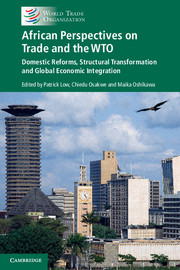 African Perspectives on Trade and the WTO
African Perspectives on Trade and the WTO Book contents
- African Perspectives on Trade and the WTO
- African Perspectives on Trade and the WTO
- Copyright page
- Contents
- Figures
- Plates
- Contributors
- Message
- Joint Foreword
- Book part
- Glossary
- Disclaimer
- 1 Introduction and Overview
- Part I The Future of the Multilateral Trading System: Perspectives from African Policy-Makers and Partners
- Part II Africa’s Participation in the Rules-Based Multilateral Trading System
- 10 Rising Africa in World Trade? A Story of Traditional Commodities and New Products
- 11 Trade Policy Trends in Africa: Empirical Evidence from Twenty Years of WTO Trade Policy Reviews
- 12 Preferential Trade Agreements in Africa: Lessons from the Tripartite Free Trade Agreements and an African Continent-Wide FTA
- 13 African Trade Integration and International Production Networks
- 14 Implementing Trade Facilitation Reform in Africa
- Part III Selected Development Experiences and Perspectives
- Book part
- Index
- Plate Section (PDF Only)
- Book part
- References
13 - African Trade Integration and International Production Networks
from Part II - Africa’s Participation in the Rules-Based Multilateral Trading System
Published online by Cambridge University Press: 27 October 2016
- African Perspectives on Trade and the WTO
- African Perspectives on Trade and the WTO
- Copyright page
- Contents
- Figures
- Plates
- Contributors
- Message
- Joint Foreword
- Book part
- Glossary
- Disclaimer
- 1 Introduction and Overview
- Part I The Future of the Multilateral Trading System: Perspectives from African Policy-Makers and Partners
- Part II Africa’s Participation in the Rules-Based Multilateral Trading System
- 10 Rising Africa in World Trade? A Story of Traditional Commodities and New Products
- 11 Trade Policy Trends in Africa: Empirical Evidence from Twenty Years of WTO Trade Policy Reviews
- 12 Preferential Trade Agreements in Africa: Lessons from the Tripartite Free Trade Agreements and an African Continent-Wide FTA
- 13 African Trade Integration and International Production Networks
- 14 Implementing Trade Facilitation Reform in Africa
- Part III Selected Development Experiences and Perspectives
- Book part
- Index
- Plate Section (PDF Only)
- Book part
- References
Summary
African trade is heavily concentrated in agricultural and natural resource-based commodities, sectors that are highly embedded in international value chains. There has been significant trade dynamism in recent years, driven by greater participation by African firms and communities in value chains, especially in products like fresh produce and flowers. Much of this trade and production is for end markets in Europe, but there is also increasing trade of this type within Africa in some manufacturing sectors as well as within services such as tourism. Intra-regional trade remains well below potential, however, and the challenge to diversify trade and increase the value-added share of African trade continues to confront most African economies. There are improving prospects for this as a result of intra-African policy changes, ranging from a greater focus on trade facilitation to the ambition of creating a continental free trade area. A steep increase in supply chain trade in Africa is possible in coming decades if efforts continue to put in place a supporting policy environment. This must centre on substantially lowering trade costs for African firms by implementing trade facilitation measures, especially for intra-regional trade flows, and improving the productivity of transport, logistics and related services that determine the feasibility of efficiently operating regional value chains.
- Type
- Chapter
- Information
- African Perspectives on Trade and the WTODomestic Reforms, Structural Transformation and Global Economic Integration, pp. 269 - 294Publisher: Cambridge University PressPrint publication year: 2016


